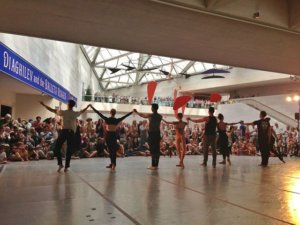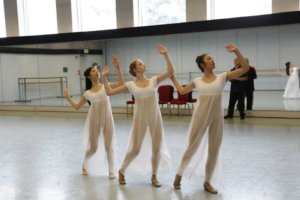
Kirov Academy of Ballet of Washington performance in honor of the Ballets Russes
As an accompaniment to this fabulous show at the National Gallery of Art in Washington, DC, students from the Kirov Academy of Ballet of Washington, DC performed excerpts from L’apres-midi d’un Faune (Afternoon of a Faun) and The Firebird on July 13, 2013 in two standing-room-only performances on the mezzanine just outside of the gallery where show is mounted.
The performance was introduced by Martin Fredmann, artistic director of the Kirov Academy who was justifiably proud of the young dancers. Offering a high school diploma in addition to dance studies, the Academy places an astonishing 75 percent of its graduates in major dance companies around the world. After this performance, it’s easy to see why.

Nymphs from L’apres-midi d’un Faune (rehearsal photograph)
Fredmann told the audience that Claude Debussy, in creating music for L’apres-midi d’un Faune, was inspired by the French symbolist poet, Stefan Mallarme’s poem of the same name, while Nijinsky took the naturalistic choreography of Michel Fokine in a new direction, devising “archaic” movements recalling the stylized front-facing figures on ancient amphorae. Fredmann invited the audience, lacking a curtain, to close their eyes and “await the magic.” As the music began, there was young Emerson Moose atop a large rock apparently sunning himself until the gauzily-clad nymphs appear. A beguiling Faune dressed in skin-colored leotard and tights, Moose was a lithe sprite to the nymphs’ more reserved progress across the stage. Bailey Anglin, as the lead nymph, carried a raspberry scarf as enticement to the Faune. Once the nymphs have vanished and our Faune is left only with the scarf, he mounted his rock with deliberate steps, lay face-down upon it, and turned to extend one leg in an insouciant way, as if to say, look at my beautiful leg. I alone am enough!
 During the interval between performances, Fredmann talked about Natalia Gonchorova’s complete redesign of the Firebird set (see my earlier blog post http://ellenkwatnoski.com/2013/07/07/lush-life-part-ii-when-art-danced-with-music-diaghilev-and-the-ballets-russes-1909-1929/) with the vast onion-dome backcloth and brilliant costumes. Her version was the standard until Marc Chagall did new sets for a 1949 performance with Maria Tallchief as Firebird. Based upon a Russian folk-tale, The Firebird tells the tale of a prince who climbs a wall and finds an enchanted garden owned by an evil wizard. Golden apples hang from the trees, but they pale in comparison to a half-woman, half-bird creature—the magical Firebird he sees there. Dashing Prince Ivan, again danced beautifully by Emerson Moose, spies the exquisite Firebird and hides behind a tree to watch her flit and preen and enjoy being a fiery bird-girl. But, alas, watching is not enough and he must capture the bird, danced by fifteen-year-old Riho Sakamoto. With costumes worthy of Leon Bakst, these lovely dancers made the old folktale come to life without sets, lights, or onion domes. Sakamoto is an astonishingly mature dancer, delicate yet strong, with her bird-like head movements, gorgeous extensions and beautiful line. Her struggle with the Prince was complex dramatically—one had the sense she enjoyed being caught, even as she fights against capture. Perhaps this notion is confirmed when she plucks an enchanted feather from her plumage and bestows it upon the dazzled Prince. Sakamoto and Moose enjoyed a standing ovation from the appreciative audience, both on the mezzanine and literally hanging from the stairwells. Balletomanes: remember those names: Riho Sakamoto and Emerson Moose!
During the interval between performances, Fredmann talked about Natalia Gonchorova’s complete redesign of the Firebird set (see my earlier blog post http://ellenkwatnoski.com/2013/07/07/lush-life-part-ii-when-art-danced-with-music-diaghilev-and-the-ballets-russes-1909-1929/) with the vast onion-dome backcloth and brilliant costumes. Her version was the standard until Marc Chagall did new sets for a 1949 performance with Maria Tallchief as Firebird. Based upon a Russian folk-tale, The Firebird tells the tale of a prince who climbs a wall and finds an enchanted garden owned by an evil wizard. Golden apples hang from the trees, but they pale in comparison to a half-woman, half-bird creature—the magical Firebird he sees there. Dashing Prince Ivan, again danced beautifully by Emerson Moose, spies the exquisite Firebird and hides behind a tree to watch her flit and preen and enjoy being a fiery bird-girl. But, alas, watching is not enough and he must capture the bird, danced by fifteen-year-old Riho Sakamoto. With costumes worthy of Leon Bakst, these lovely dancers made the old folktale come to life without sets, lights, or onion domes. Sakamoto is an astonishingly mature dancer, delicate yet strong, with her bird-like head movements, gorgeous extensions and beautiful line. Her struggle with the Prince was complex dramatically—one had the sense she enjoyed being caught, even as she fights against capture. Perhaps this notion is confirmed when she plucks an enchanted feather from her plumage and bestows it upon the dazzled Prince. Sakamoto and Moose enjoyed a standing ovation from the appreciative audience, both on the mezzanine and literally hanging from the stairwells. Balletomanes: remember those names: Riho Sakamoto and Emerson Moose!
 If you come to the August 11, 2013 performance by Dana Tae Soon Burgess you’ll see original choreography premiered in a suite of dances “inspired by the spirit of the Ballets Russes.” Come early! There will be two performances at 1:30 and 3:30, best seen from the front rows or standing in the back of the performance space. The riser is low enough to provide a limited line of sight much further back than the third or fourth row.
If you come to the August 11, 2013 performance by Dana Tae Soon Burgess you’ll see original choreography premiered in a suite of dances “inspired by the spirit of the Ballets Russes.” Come early! There will be two performances at 1:30 and 3:30, best seen from the front rows or standing in the back of the performance space. The riser is low enough to provide a limited line of sight much further back than the third or fourth row.
Learn more about Dana Tae Soon Burgess: http://www.dtsbco.com/home/home.html
There’s still time to see the show: http://www.nga.gov/content/ngaweb/exhibitions/2013/diaghilev.html
On view until October 6, 2013, the exhibition is well worth seeing, with or without a dance performance accompanying it. Bravo to the National Gallery, the Victoria & Albert Museum (owners of the costume collection), and now, the Kirov Academy of Ballet of Washington, DC. https://kirovacademydc.org/













